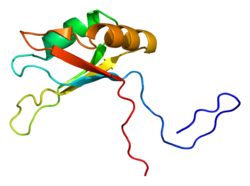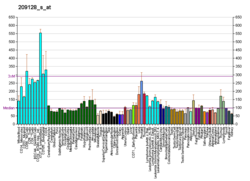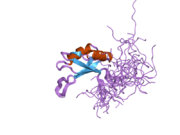SART3
SART3| SART3 | |||||||||||||||||||||||||
|---|---|---|---|---|---|---|---|---|---|---|---|---|---|---|---|---|---|---|---|---|---|---|---|---|---|
 | |||||||||||||||||||||||||
| |||||||||||||||||||||||||
| 식별자 | |||||||||||||||||||||||||
| 에일리어스 | SART3, DSAP1, P100, RP11-13G14, TIP110, p110, p110(nrb), T세포3에서 인식되는 편평세포암항원, T세포3에서 인식되는 편평세포암항원, 스플라이소좀관련인자3, U4/U6단백질재활용 | ||||||||||||||||||||||||
| 외부 ID | OMIM: 611684 MGI: 1858230 HomoloGene: 40977 GeneCard: SART3 | ||||||||||||||||||||||||
| |||||||||||||||||||||||||
| |||||||||||||||||||||||||
| |||||||||||||||||||||||||
| |||||||||||||||||||||||||
| 맞춤법 | |||||||||||||||||||||||||
| 종. | 인간 | 마우스 | |||||||||||||||||||||||
| 엔트레즈 | |||||||||||||||||||||||||
| 앙상블 | |||||||||||||||||||||||||
| 유니프로트 | |||||||||||||||||||||||||
| RefSeq(mRNA) | |||||||||||||||||||||||||
| RefSeq(단백질) | |||||||||||||||||||||||||
| 장소(UCSC) | Chr 12: 108.52 ~108.56 Mb | Chr 5: 113.88 ~113.91 Mb | |||||||||||||||||||||||
| PubMed 검색 | [3] | [4] | |||||||||||||||||||||||
| 위키데이터 | |||||||||||||||||||||||||
| |||||||||||||||||||||||||
T세포3에 의해 인식되는 편평세포암 항원은 SART3 [5][6][7]유전자에 의해 인체 내에서 코드되는 단백질이다.
이 유전자에 의해 코드된 단백질은 종양 거부 항원인 RNA 결합 핵단백질이다.이 항원은 암환자의 HLA-A24 제한적 종양 특이적 세포독성 T림프구를 유도할 수 있는 종양 에피토프를 가지고 있어 특정 면역요법에 유용할 수 있다.이 유전자 제품은 HIV-1 유전자 발현과 바이러스 복제에 중요한 세포 인자로 밝혀졌다.또한 스플라이세오솜 사이클의 재활용 단계에서 U6 및 U4/U6 snRNP와 일시적으로 관련됩니다.이 암호화된 단백질은 mRNA 스플라이싱 [7]조절에 관여하는 것으로 생각된다.
상호 작용
SART3는 RNPS1[8] 및 Androgen [9]수용체와 상호작용하는 것으로 나타났다.
레퍼런스
- ^ a b c GRCh38: 앙상블 릴리즈 89: ENSG000075856 - 앙상블, 2017년 5월
- ^ a b c GRCm38: 앙상블 릴리즈 89: ENSMUSG000018974 - 앙상블, 2017년 5월
- ^ "Human PubMed Reference:". National Center for Biotechnology Information, U.S. National Library of Medicine.
- ^ "Mouse PubMed Reference:". National Center for Biotechnology Information, U.S. National Library of Medicine.
- ^ Nagase T, Seki N, Tanaka A, Ishikawa K, Nomura N (August 1995). "Prediction of the coding sequences of unidentified human genes. IV. The coding sequences of 40 new genes (KIAA0121-KIAA0160) deduced by analysis of cDNA clones from human cell line KG-1". DNA Research. 2 (4): 167–74, 199–210. doi:10.1093/dnares/2.4.167. PMID 8590280.
- ^ Harada K, Yamada A, Mine T, Kawagoe N, Takasu H, Itoh K (February 2000). "Mouse homologue of the human SART3 gene encoding tumor-rejection antigen". Japanese Journal of Cancer Research. 91 (2): 239–47. doi:10.1111/j.1349-7006.2000.tb00937.x. PMC 5926322. PMID 10761712.
- ^ a b "Entrez Gene: SART3 squamous cell carcinoma antigen recognized by T cells 3".
- ^ Harada K, Yamada A, Yang D, Itoh K, Shichijo S (September 2001). "Binding of a SART3 tumor-rejection antigen to a pre-mRNA splicing factor RNPS1: a possible regulation of splicing by a complex formation". International Journal of Cancer. 93 (5): 623–8. doi:10.1002/ijc.1391. PMID 11477570. S2CID 24724555.
- ^ Liu Y, Kim BO, Kao C, Jung C, Dalton JT, He JJ (May 2004). "Tip110, the human immunodeficiency virus type 1 (HIV-1) Tat-interacting protein of 110 kDa as a negative regulator of androgen receptor (AR) transcriptional activation". The Journal of Biological Chemistry. 279 (21): 21766–73. doi:10.1074/jbc.M314321200. PMID 15031286.
추가 정보
- Maruyama K, Sugano S (January 1994). "Oligo-capping: a simple method to replace the cap structure of eukaryotic mRNAs with oligoribonucleotides". Gene. 138 (1–2): 171–4. doi:10.1016/0378-1119(94)90802-8. PMID 8125298.
- Suzuki Y, Yoshitomo-Nakagawa K, Maruyama K, Suyama A, Sugano S (October 1997). "Construction and characterization of a full length-enriched and a 5'-end-enriched cDNA library". Gene. 200 (1–2): 149–56. doi:10.1016/S0378-1119(97)00411-3. PMID 9373149.
- Yang D, Nakao M, Shichijo S, Sasatomi T, Takasu H, Matsumoto H, Mori K, Hayashi A, Yamana H, Shirouzu K, Itoh K (August 1999). "Identification of a gene coding for a protein possessing shared tumor epitopes capable of inducing HLA-A24-restricted cytotoxic T lymphocytes in cancer patients". Cancer Research. 59 (16): 4056–63. PMID 10463607.
- Tanaka S, Tsuda N, Kawano K, Sakamoto M, Nishida T, Hashimoto T, Shichijo S, Kamura T, Itoh K (November 2000). "Expression of tumor-rejection antigens in gynecologic cancers". Japanese Journal of Cancer Research. 91 (11): 1177–84. doi:10.1111/j.1349-7006.2000.tb00902.x. PMC 5926290. PMID 11092984.
- Harada K, Yamada A, Yang D, Itoh K, Shichijo S (September 2001). "Binding of a SART3 tumor-rejection antigen to a pre-mRNA splicing factor RNPS1: a possible regulation of splicing by a complex formation". International Journal of Cancer. 93 (5): 623–8. doi:10.1002/ijc.1391. PMID 11477570. S2CID 24724555.
- Sasatomi T, Suefuji Y, Matsunaga K, Yamana H, Miyagi Y, Araki Y, Ogata Y, Itoh K, Shirouzu K (March 2002). "Expression of tumor rejection antigens in colorectal carcinomas". Cancer. 94 (6): 1636–41. doi:10.1002/cncr.10421. PMID 11920522. S2CID 33045822.
- Liu Y, Li J, Kim BO, Pace BS, He JJ (June 2002). "HIV-1 Tat protein-mediated transactivation of the HIV-1 long terminal repeat promoter is potentiated by a novel nuclear Tat-interacting protein of 110 kDa, Tip110". The Journal of Biological Chemistry. 277 (26): 23854–63. doi:10.1074/jbc.M200773200. PMID 11959860.
- Bell M, Schreiner S, Damianov A, Reddy R, Bindereif A (June 2002). "p110, a novel human U6 snRNP protein and U4/U6 snRNP recycling factor". The EMBO Journal. 21 (11): 2724–35. doi:10.1093/emboj/21.11.2724. PMC 126028. PMID 12032085.
- Nottrott S, Urlaub H, Lührmann R (October 2002). "Hierarchical, clustered protein interactions with U4/U6 snRNA: a biochemical role for U4/U6 proteins". The EMBO Journal. 21 (20): 5527–38. doi:10.1093/emboj/cdf544. PMC 129076. PMID 12374753.
- Nakayama M, Kikuno R, Ohara O (November 2002). "Protein-protein interactions between large proteins: two-hybrid screening using a functionally classified library composed of long cDNAs". Genome Research. 12 (11): 1773–84. doi:10.1101/gr.406902. PMC 187542. PMID 12421765.
- Stanĕk D, Rader SD, Klingauf M, Neugebauer KM (February 2003). "Targeting of U4/U6 small nuclear RNP assembly factor SART3/p110 to Cajal bodies". The Journal of Cell Biology. 160 (4): 505–16. doi:10.1083/jcb.200210087. PMC 2173746. PMID 12578909.
- Damianov A, Schreiner S, Bindereif A (February 2004). "Recycling of the U12-type spliceosome requires p110, a component of the U6atac snRNP". Molecular and Cellular Biology. 24 (4): 1700–8. doi:10.1128/MCB.24.4.1700-1708.2004. PMC 344176. PMID 14749385.
- Liu Y, Kim BO, Kao C, Jung C, Dalton JT, He JJ (May 2004). "Tip110, the human immunodeficiency virus type 1 (HIV-1) Tat-interacting protein of 110 kDa as a negative regulator of androgen receptor (AR) transcriptional activation". The Journal of Biological Chemistry. 279 (21): 21766–73. doi:10.1074/jbc.M314321200. PMID 15031286.
- Brandenberger R, Wei H, Zhang S, Lei S, Murage J, Fisk GJ, Li Y, Xu C, Fang R, Guegler K, Rao MS, Mandalam R, Lebkowski J, Stanton LW (June 2004). "Transcriptome characterization elucidates signaling networks that control human ES cell growth and differentiation". Nature Biotechnology. 22 (6): 707–16. doi:10.1038/nbt971. PMID 15146197. S2CID 27764390.
- Medenbach J, Schreiner S, Liu S, Lührmann R, Bindereif A (September 2004). "Human U4/U6 snRNP recycling factor p110: mutational analysis reveals the function of the tetratricopeptide repeat domain in recycling". Molecular and Cellular Biology. 24 (17): 7392–401. doi:10.1128/MCB.24.17.7392-7401.2004. PMC 506986. PMID 15314151.
- Stanĕk D, Neugebauer KM (September 2004). "Detection of snRNP assembly intermediates in Cajal bodies by fluorescence resonance energy transfer". The Journal of Cell Biology. 166 (7): 1015–25. doi:10.1083/jcb.200405160. PMC 2172029. PMID 15452143.









